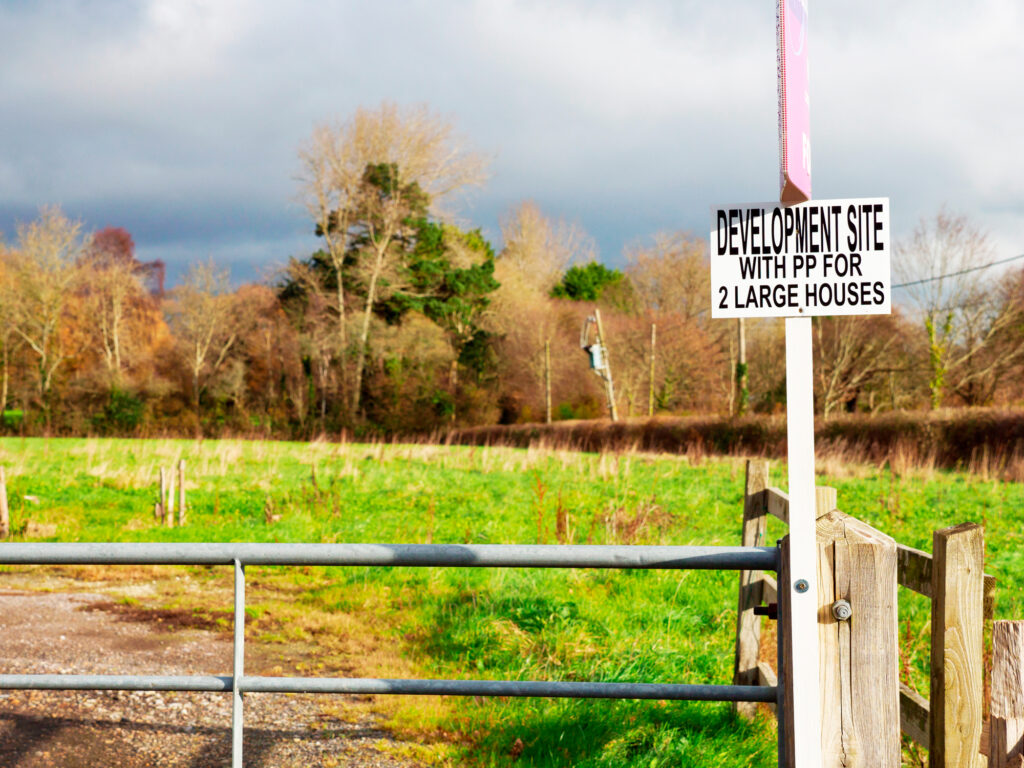
Use code BUILD for 20% off
Book here!
Use code BUILD for 20% off
Book here!Polished concrete floors are a versatile flooring option that can add a sleek, contemporary feel to any renovation or self build project. Their smooth, seamless look and texture will add an industrial style to a home, enhancing both modern interiors and traditional, period schemes.
Polished concrete floors were originally found in factories for their low-maintenance and durable qualities, but have become a popular solution for those looking to create a wow-factor interior. This is because they offer a flat appearance with no grout lines, which helps to maximise the feeling of space.
Polished concrete is made through combining concrete (which consists of cement, sand, water and gravel) with a chemical that increases its density. This ensures that when the concrete is poured and sanded down, it’ll eventually reveal a striking sheen that is the look we know and love as polished concrete floors.
But how can you achieve a polished concrete floor in your home and what are the key considerations for a smooth installation? From where a polished concrete floor works best to the expected costs and alternative flooring options, this is your complete guide.
Polished concrete flooring is a durable, cost-effective and safe option for your home. Some see concrete floors and are alarmed by their slippery-looking surface. However the majority of designs are finished to ensure a non-slip texture that’s still comfortable on bare feet.
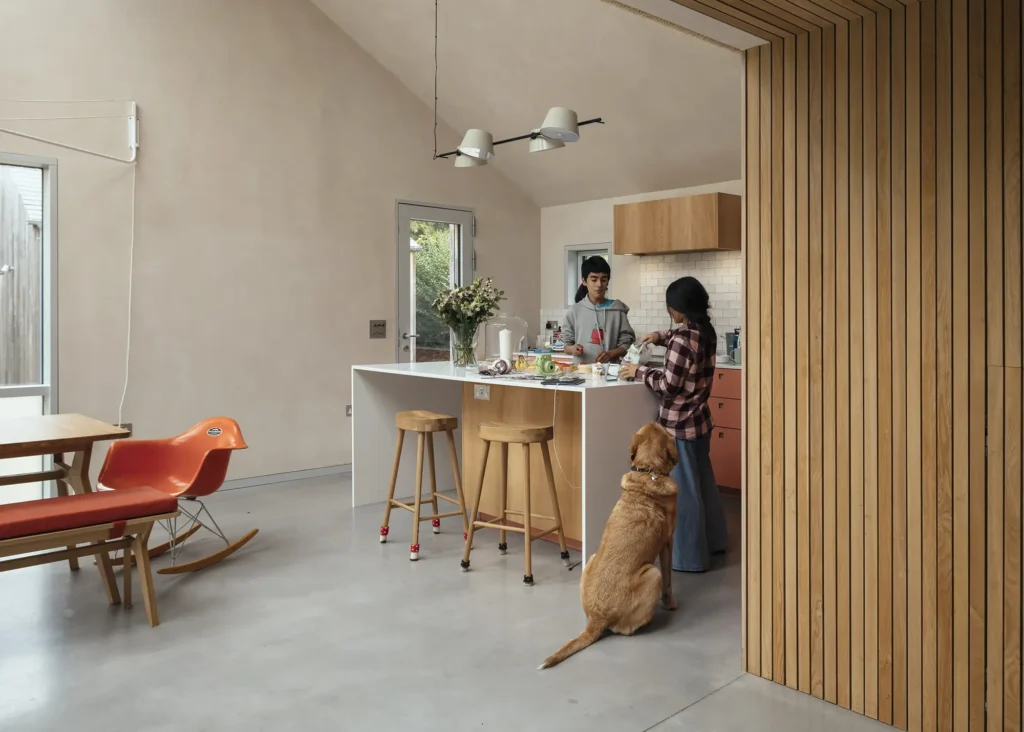
Clay Retreat by PAD Studio features polished concrete floors stretching throughout the whole open-plan downstairs. The natural, dappled look was key to the design of the home, harmonising with the exposed plaster and timber clad walls. Photo: Jim Stephenson
The material also works well with underfloor heating (UFH). This is because polished concrete floors are a good conductor and have a high thermal mass, so will retain the heat evenly produced without any cold spots.
It even stores warmth acquired from solar gain (heat from the sun that comes into your home through windows and glazed doors) and recycles it as internal temperatures cool – helping to maintain an even climate. You can also choose from a range of colours and textures to complement your interior scheme. Most will opt for the neutral grey shade as this has an understated, contemporary feel that won’t overwhelm other features in your home.
Polished concrete floors can also create a similar look to luxury materials such as granite and marble, while potentially saving you money on the hefty price tag. Polished concrete floors will cost you around £130 to £160 per m².
This puts it in the same bracket as high-end stone tile floorings. But you won’t have to worry about the cost of screeding the floor first. If you already have a concrete floor, this can be sanded down to create a polished concrete floor for around £50 per m².
Polished concrete floors are ideal for creating a seamless link between inside and out, especially when connecting a kitchen-diner with the garden through glazed sliding doors or bifold foors. The light-reflective and robust material holds up well in high traffic areas, which is why you’ll find it on many shop floors, too.
Depending on its condition, it may be possible to polish an existing concrete floor, if it’s in good enough condition. This is common in basement conversions or when transforming warehouses and industrial structures into residential properties.
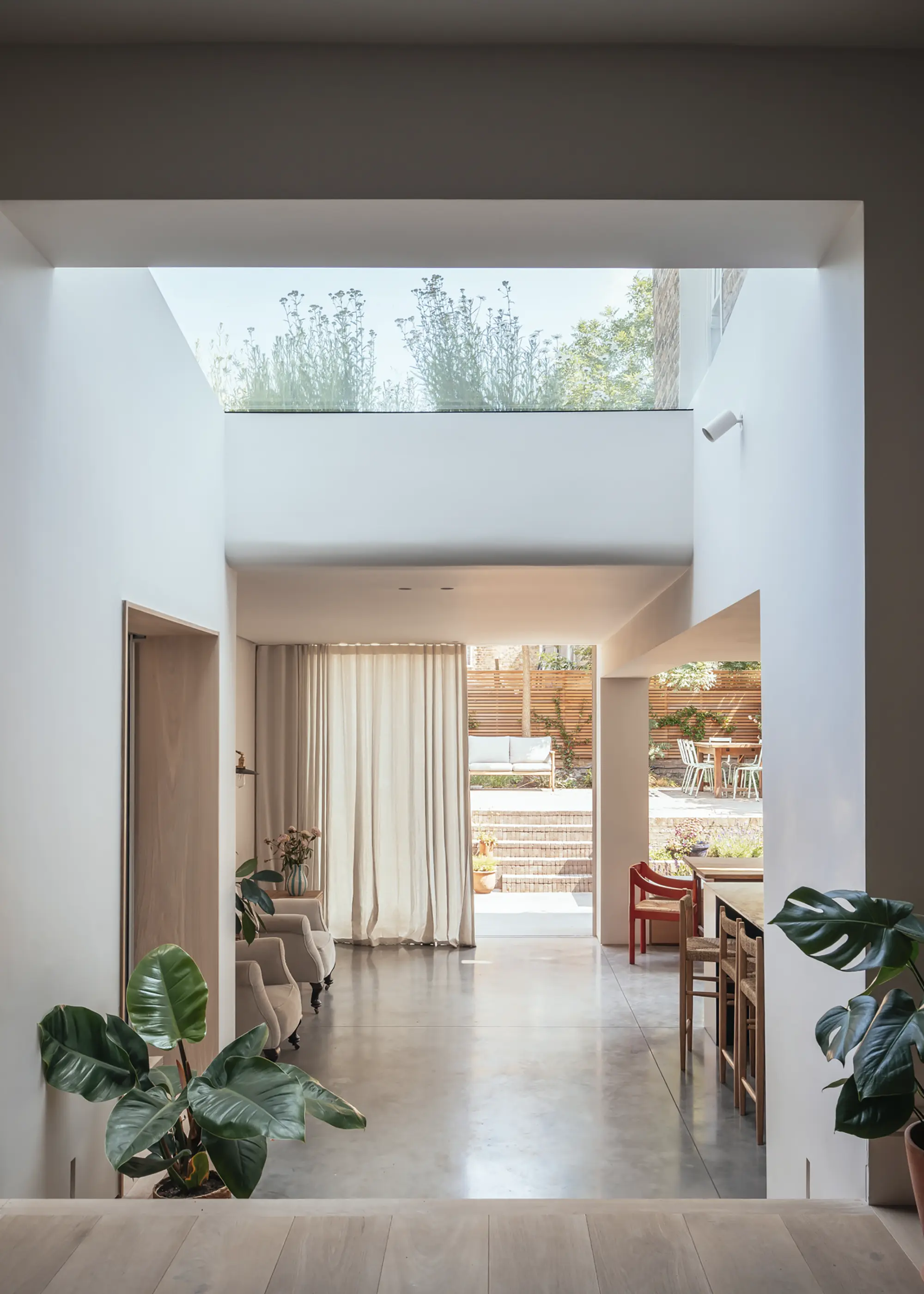
Oliver Leech Architects have transformed this Victorian house, set within a conservation area in Herne Hill. As part of the home’s extension and interior redesign, the architects specified polished concrete flooring from Steyson Concrete Flooring, which is carried from the kitchen-diner out to the patio for a seamless look that connects the indoor and outdoor spaces. Photo: Jim Stephenson
It’s generally easiest to install polished concrete flooring in a new build project or brand-new extension. This is because you can easily plan for an arrangement that supports the weight of the concrete and ensure you’re getting a level pour.
However, a retrofitting scenario is also possible. When applying concrete retrospectively you will need to consider whether the floor structure can take the extra weight (around 200kg per m²). You should also allow for the fact that the ceiling height within an existing property will be reduced by a least 100mm.
Polished concrete floors look great, how how are they made? It starts with concrete, which is made by combining cement, gravel, sand and water. The mixture is then usually poured onto a steel and fibre-reinforced mesh, which minimises the risk of cracking.
If you’re fitting underfloor heating, the concrete should be installed on top of the pipes. Either way, it will then be levelled and compacted using internal or external vibration. This will remove any air pockets and surface voids, which could otherwise reduce the strength and durability of the material.
Depending on your desired finish, a plain or coloured hardener (known as a dry shaker) is added to the concrete’s surface. This is smoothed using a power float machine featuring a large, round flat disc for rough grinding the concrete. The job can be repeated between four to eight times to achieve the desired effect until you have perfect polished concrete floors.
CASE STUDY Modern Renovation & Extension of a Victorian HomeIn order to achieve the contemporary look they were after, Stephen and Laura specified polished concrete flooring – and they’re delighted with the result. “We could have gone for a slightly cheaper covering, but we didn’t want to compromise on materials in this area of the house,” says Stephen.
“It’s not so much the concrete we love, but the absence of joints. You just wouldn’t get the same look with tiles, so I’m pleased with our decision.” As well as the striking aesthetic this seamless surface creates, the flooring is an excellent partner for the underfloor heating that has been laid throughout the house. It’s highly-efficient in terms of its thermal mass. |
Treatment should start when the concrete is hard enough to hold the weight of the machine and operator. However, it should not be so dry that the power floater cannot trim the high spots or fill the lows effectively.
Most polished concrete floors are cast in one section, temporarily covered and left to cure. This process will be much faster in the warmer months. After a month the concrete is uncovered, cleaned, mopped and burnished to remove any inconsistencies or footprints. At this point some companies will simply apply a matt, satin or gloss sealant to achieve the desired polished concrete floor appearance.
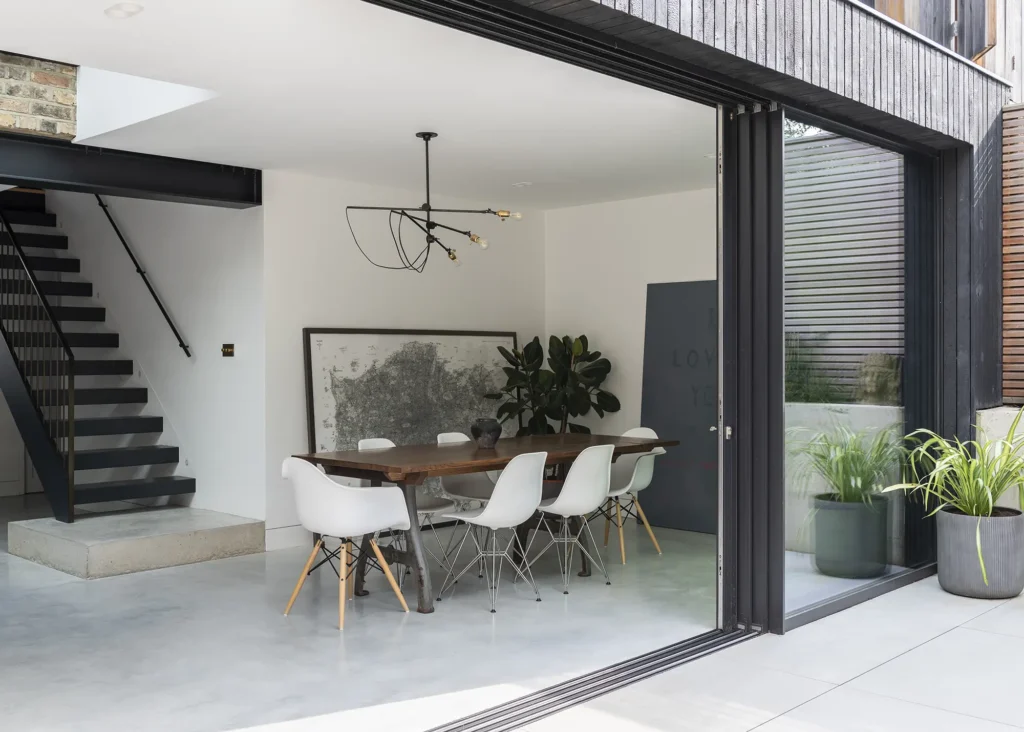
Paul Archer Design devised an impressive multi-storey addition and complete refurbishment of this family home in Hackney. The house has been extended at the side and rear with three distinctive, cubic volumes. On the lower ground floor, the spacious kitchen has been completely opened up to the sunken garden with slimline sliding doors and a polished concrete floor that fuses seamlessly with the large patio tiles beyond. Photo: Jonathan Gooch
Technically true polished concrete floors are created and finished using a diamond grinding machine that evens out the surface. The floor is then treated with a chemical densifier to reveal a blemish-free shine. It is not considered polished concrete until a level of 400 grits is reached to achieve a glossy finish.
Polished concrete floors are ideal for those looking for a low-maintenance flooring option – they’re highly resistant to damage and can withstand heavy loads for many years. However, it’s still important to look after them to ensure the look of the polished concrete is maintained and performs as required.
Mopping regularly, around once a week is recommended. You can do this with clean, hot water, or mix this with a concrete floor-safe surface cleaner that will work to break down grease and dirt accumulated throughout the day. Remember to thoroughly rinse the floors after to avoid creating a slippery surface. It’s wise to steer clear of any products that contain bleach or strong acids, as this could detract from the shine that polished concrete floors are known and loved for.
You should wipe away any spilled drinks or other cleaning liquids as soon as possible to avoid them sitting and causing damage or discolouration.
At least 28 days must pass before freshly poured concrete can be polished. However, works such as kitchen installations can continue. It will be 6-12 months before the concrete reaches full strength, but the floor will be usable much sooner.
Sudden temperature change is the biggest reason for cracks in polished concrete floors. Laying a reinforcing mesh before the concrete pour will help minimise this.
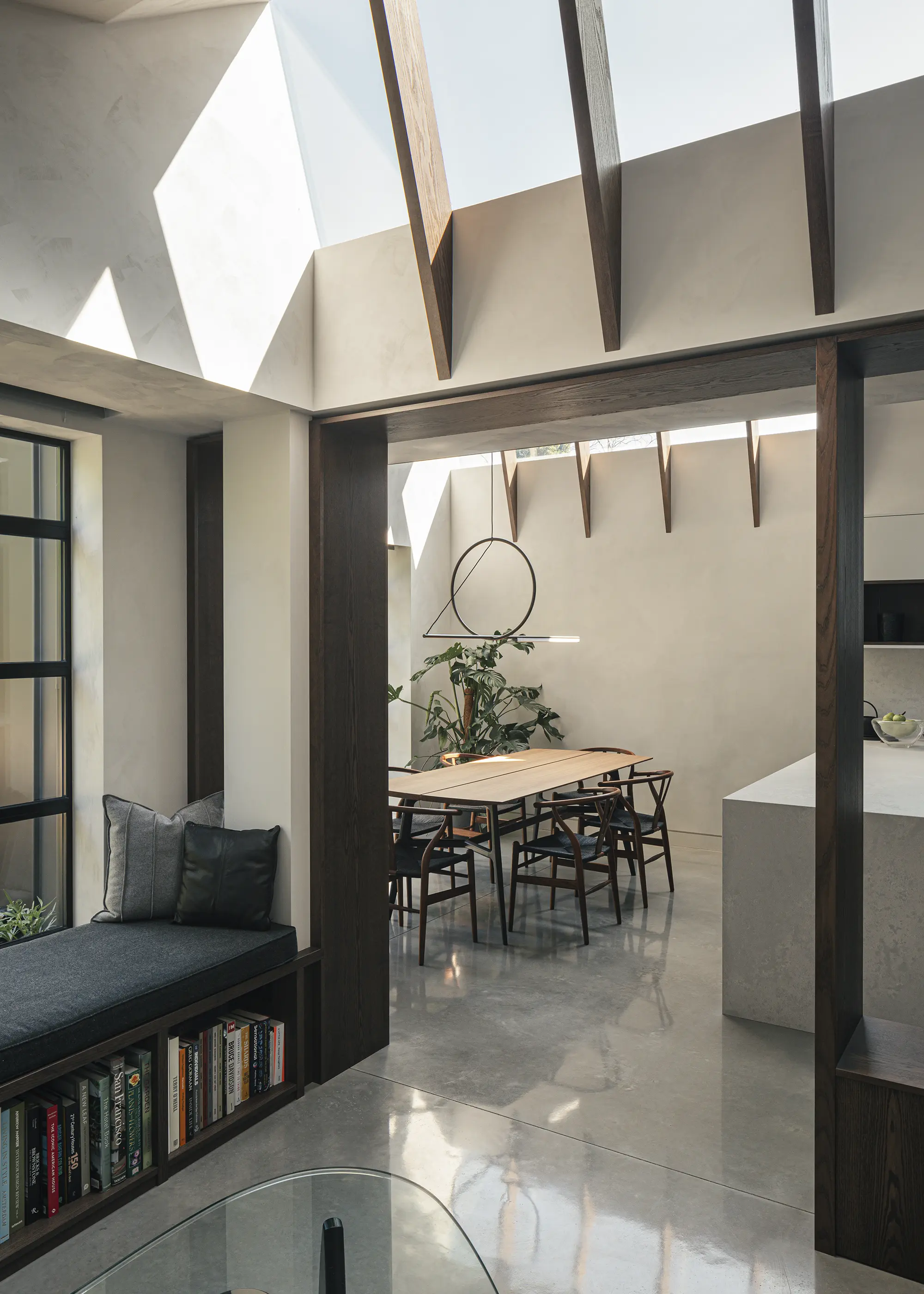
Nestled into Highgate Woods, Fraher & Findlay Architects modified this large Edwardian terraced house with a pair of striking, peaked external additions – housing space for cooking, reading, relaxing and more. A strong palette of materials has been specified internally, with bespoke timber joinery, white plaster walls, polished concrete floors and heritage-style glazing. Photo: Chris Wharton
In addition, control joints are usually cut into the concrete surface at predetermined locations, which appear as thin straight lines or grooves. This creates a deliberate weak spot so the polished concrete will shrink (crack) in a neat straight line to look like tiles and avoid breaks elsewhere down the line. The joints should be added with a neat saw within 24 hours of installing the concrete.
Polished concrete floors can be repaired if they are cracked. Cracks don’t happen often and if they do, they’re likely not serious so this isn’t something that should put you off installing a polished concrete floor. Cracks, however, can occur if there is surface tension caused by rapid temperature changes over time, for example if your underfloor heating (UFH) is turned up too high too quickly.
If you do notice a defect in your polished concrete floor, it’s wise to get it in touch with a professional, just so you’re aware of its severity and the next steps you should take. Speak to your provider or installer and look at their guarantees to see how you can work together to find a solution.
If you’re working with a budget that just won’t stretch to accommodate polished concrete floors or have found that for the floorspace, it won’t be a cost-effective option, you can replicate the look fairly easily with other materials. For example, large-format tiles, vinyl flooring or similar materials such as micro cement will offer a similar appearance.
Hardwearing and fuss-free, tiles add instant appeal and are great in bathrooms or kitchens, as they cope well in direct contact with water. Porcelain and non-slip ceramic tiles are dense and non-porous, so work well in high-traffic areas, too. Tile prices will vary as there’s so many sizes and shapes to choose from but you can expect to pay from £18 per m² up to £100+ for larger, high-end tiles.
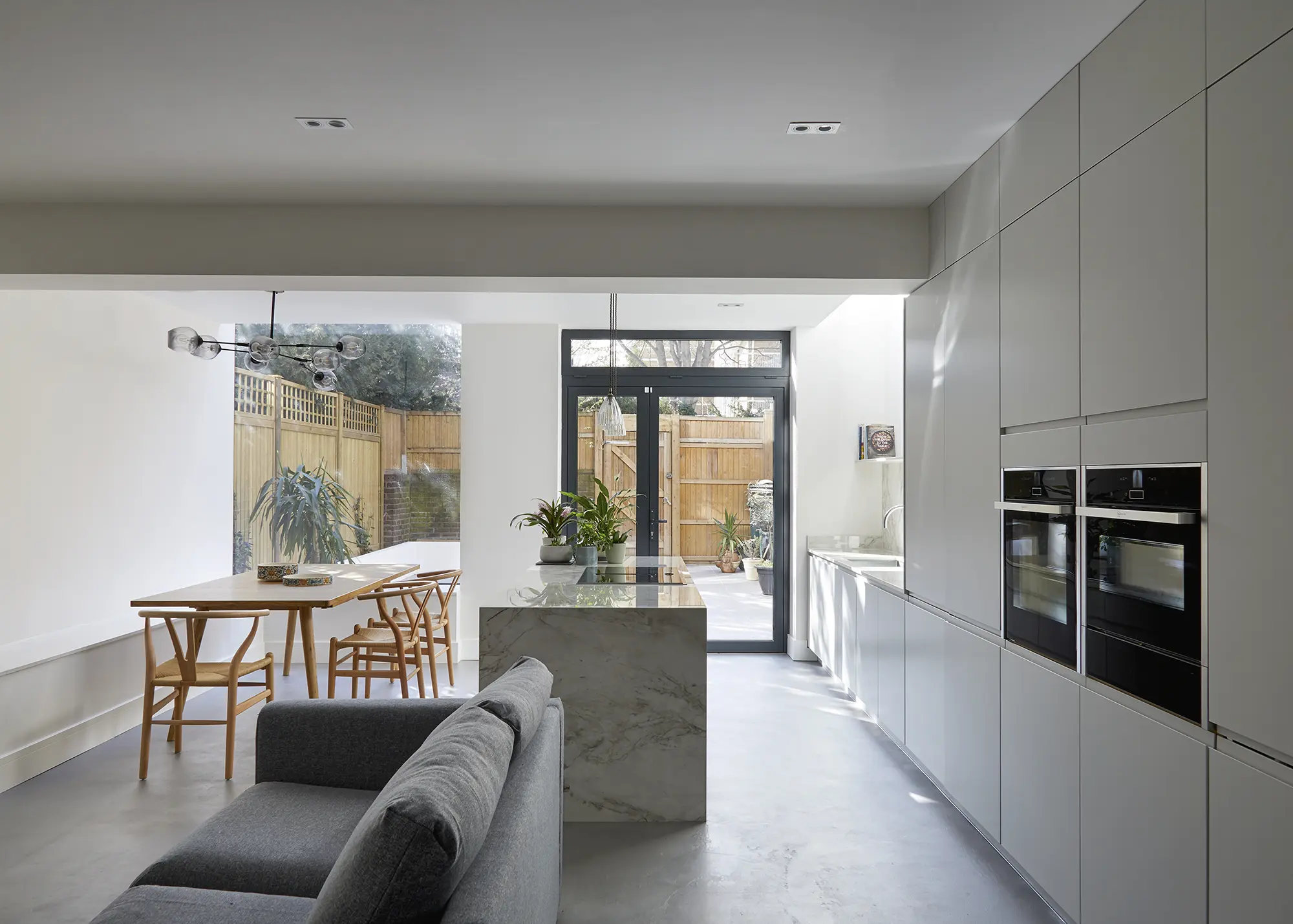
Build It readers Harry and Sara Montatt, chose microcement for the flooring in their extension, and as an alternative to plaster in the upper two bathrooms for a pared back, contemporary feel. Creating an effect similar to polished concrete, microcement offers a seamless, waterproof finish that does away with the need for grout.
Luxury vinyl tiles (LVT), lino and cushioned vinyl are all extremely easy to clean and maintain, plus the covering is warm and comfortable underfoot, and less slippery than ceramics. This type of surface offers fantastic versatility when it comes to appearance, whether that means mimicking the intricate textures of other covering options or offering a vibrant pop of colour. Luxury vinyl tiles are most commonly designed to give the appearance of stone or wood flooring but are available in a whole host of colourful patterns to suit any interior scheme.
Luxury vinyl tiles can be affordable but be aware that the price will vary dramatically depending on the style, thickness and intricacy of the pattern or design. Costs range from approximately £20 to £70 per m². You can expect lino and cushioned vinyl to come in much cheaper.
When dry, polished concrete provides decent slip resistance due to its dense, smooth surface. However, it can become slippery when wet, particularly if liquids are accidentally spilled on the floor and not cleaned up. To minimise risk, consider adding a non-slip surface finish or opting for a honed instead of glossy finish. Anti-slip treatments and mats in high-traffic areas will also help reduce any danger.
During the colder months, polished concrete can feel slightly chilly underfoot. As concrete has high thermal mass, however, it absorbs and holds heat or cold from its surroundings – which can be both a pro and con for homeowners. On the upside, it pairs well with underfloor heating, which can turn it into a warm, comfortable surface. Without heating, it may feel colder compared to timber floors or carpet. You can combat this with placing rugs around the zone, especially in living spaces or dining areas where you’re likely to be spending more time.
Concrete is a versatile material and can be tinted to create a striking flooring feature. Colour can be added in several ways – such as through colour pigments mixed into the concrete before pouring and polishing, surface stains, or dyes applied during the polishing phase. Each method will offer a different look, from subtle shades to bold, vibrant tones. Keep in mind that the results can vary depending on the concrete mix and surface condition. It’s best to consult and work with an experienced contractor – you’ll be able to test samples beforehand to get a feel for how the finished flooring could look.
Polished concrete is a great flooring solution for those with pets – largely due to the fact that it’s easy to clean, hypoallergenic and doesn’t trap pet hair or odours. It has a dense, sealed surface, too, so resists scratches better than softer flooring like wood or vinyl – pet claws are therefore unlikely to cause significant damage. However, while deep gouges are rare, light surface marks may appear over time, which can actually add a slight charm to the floor’s natural texture.
Traditional concrete is heavy, so if you’re considering it for your second-storey rooms, you’ll need to ensure the floor/ceiling structure has been carefully engineered to support the load (often requiring reinforced joists or steel framing). An architect or structural engineer will be able to offer you advice based on your specific project. If concrete isn’t a viable option, you could consider concrete-look vinyl or tiles (these are a more budget-friendly solution, too).
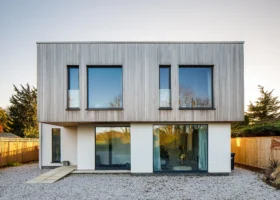
Comments are closed.